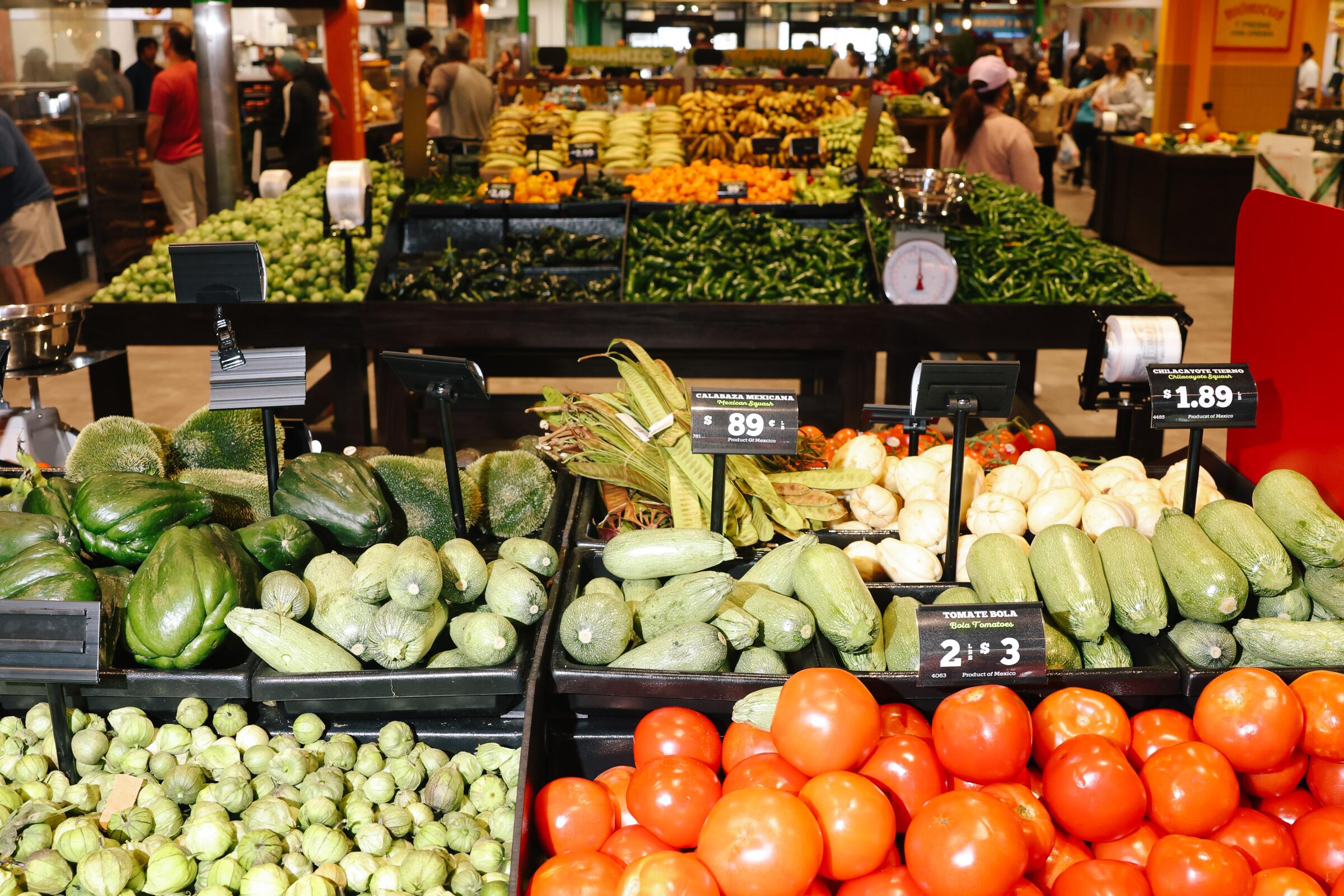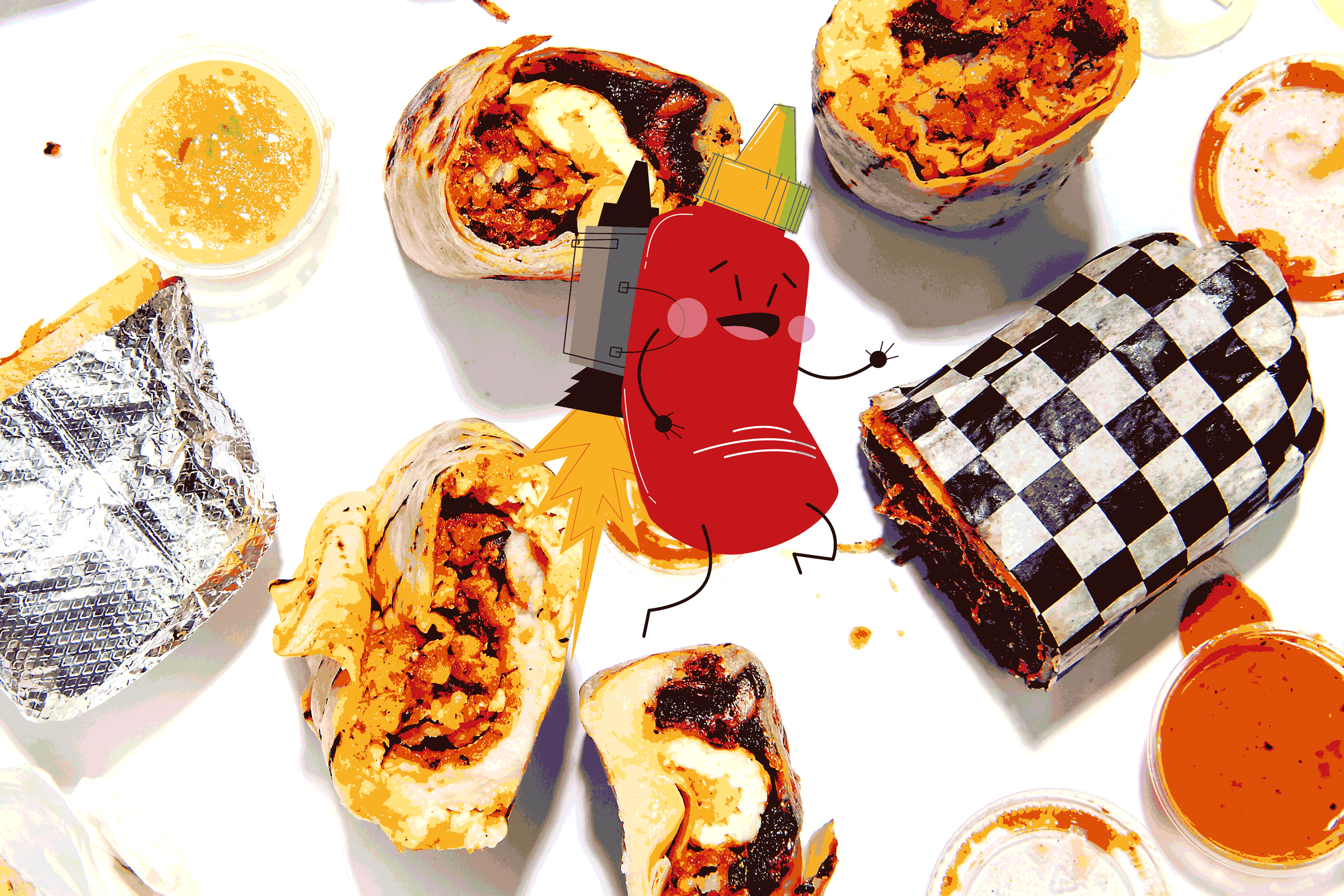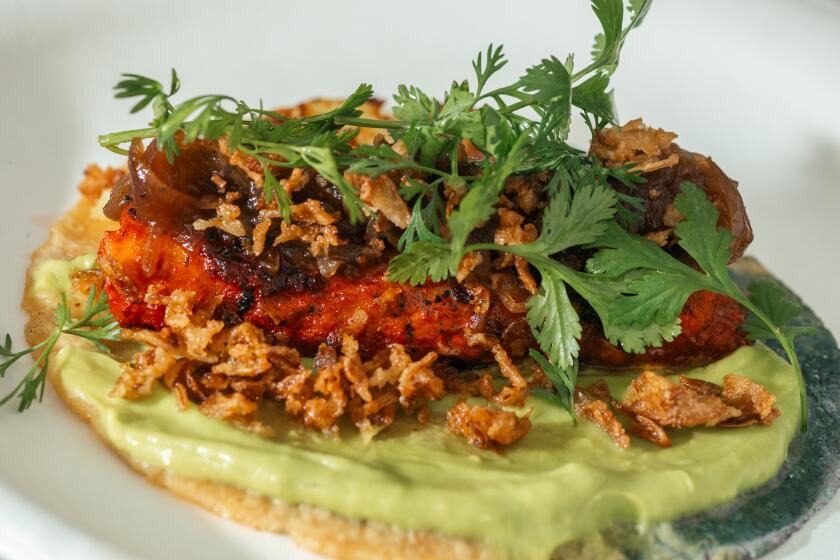Bill Addison is the restaurant critic of the Los Angeles Times. He is recipient of the 2023 Craig Claiborne Distinguished Restaurant Review Award from the James Beard Foundation, among numerous other accolades. Addison was previously national critic for Eater and held food critic positions at the San Francisco Chronicle, the Dallas Morning News and Atlanta magazine.
There was immediate civic buy-in when Mercado González opened in November. Half a year in, how do the stalls stack up? Is fine-dining Maizano its own magnet?
1
A thousand stimuli charge your senses when you walk into the Mercado González in Costa Mesa.
Dragon fruit, colored in lucid pinks and greens, piled in a wooden bin among dozens of other fruits and vegetables displayed with a gallerist’s fastidious eye. The sunshine smell of masa, maybe mingling with the piercing scent of carnitas bubbling slowly in lard. Voices ringing like applause through 70,000 square feet — or maybe that’s actual clapping for the mariachi trio playing onstage in the food court. Your brain registers colorful signs for aguas frescas, mariscos and chicharrones, but you start by reaching for a pile of packaged tortillas near the entrance. They’re still warm.
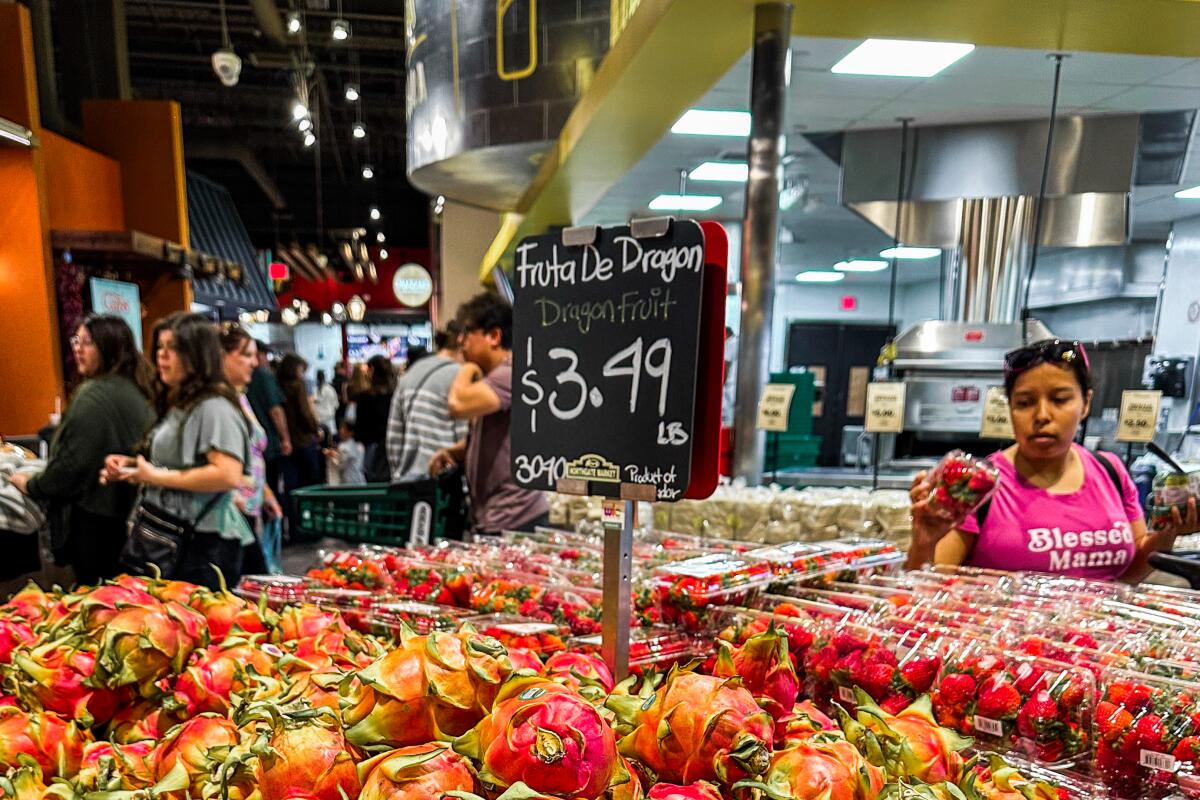
Customers shop at Mercado González, which is both a grocery and food hall. A thousand stimuli charge the senses as soon as you enter, our critic writes.
(Bill Addison / Los Angeles Times)
Don Miguel and Doña Teresa González founded the Northgate Market chain in Anaheim in 1980; the company currently operates more than 40 locations throughout Southern California. The opening of Mercado González in November marks a new level of ambition for Northgate, now led by generations of family members: The enormous space seamlessly entwines a Mexican supermarket with a food hall anchored by over a dozen puestos (permanent stalls) and a finer-dining restaurant called Maizano.
Its scale at first overwhelms and exhilarates, but the mercado has quickly settled into useful everydayness. Customers stroll unhurriedly at all hours, chucking (among an approximate zillion choices) bunches of cilantro, dried chiles, coffee creamer and containers of preseasoned steak into their carts. A few loners meander with tacos or tortas in hand. Many more couples and families attempt to camp out at tables in the muraled food court or its adjoining, shaded patio. Vying for seats becomes cutthroat on weekends, when the place is mobbed and parking is a nightmare — the valet stand starts to feel like a practical option after circling for the fifth time — but the live music inside helps dispel the initial hassle.
Half a year in, the crowds show no signs of thinning.
Breakfast burritos are the emblem of the morning meal in L.A. Here are our top choices.
As I’ve returned again and again over recent months, one stomach attempting to survey the puestos’ hundreds of culinary possibilities, it’s been stirring to witness the near-instant civic buy-in around the mercado. The curation reflects decades of business savvy, no question, but no amount of marketing or messaging could inspire the multigenerational scene on Saturday night, a parade of souls dancing, patrons downing a third shot of tequila or singling out the most unblemished head of lettuce under one roof. The community, it seems, has quickly chosen this place, giving it lifeblood as a vital third space.
These are 10 favorite ways to savor the mercado. It’s only a beginning, and I didn’t ignore the tamales, the spatchcocked pollo adobado and the paleta de fresa con crema. Those I took home (or ate in the car). Here I zero in on dishes I most enjoy eating within the mercado’s ever-resounding walls.

Shoppers walk in the jammed parking lot of Mercado González. The valet stand starts feeling like a practical option after circling for the fifth time
(Dania Maxwell / Los Angeles Times)
2
Aguachile rojo at Mariscos El Pariente
It makes sense to begin with El Pariente, given its beckoning location near the mercado’s entrance and the near-instant nourishment it provides. An overhead menu details a mix of cocteles and campechanas made to order, many highlighting shrimp harvested from the Sea of Cortez. Even more immediate: the long counter exhibiting ceviches and aguachiles in steel bowls over ice. One might include diced mango among pearly seafood; others take on an emerald cast from the base of fresh green chiles in their marinade.
I’m partial to the aguachile rojo for its inclusion of shrimp and scallops — their snappy-silken contrasts are especially satisfying — and for the smoky undertones imparted by guajillos. But no need to choose one: Order small portions of several mariscos to purchase along with some crisped tortillas for make-them-yourself tostadas. The blue-tiled counter along the stand is often some of the easiest seating to nab in the building, and caddies full of five or six different hot sauces make for endless experiments in flavor.
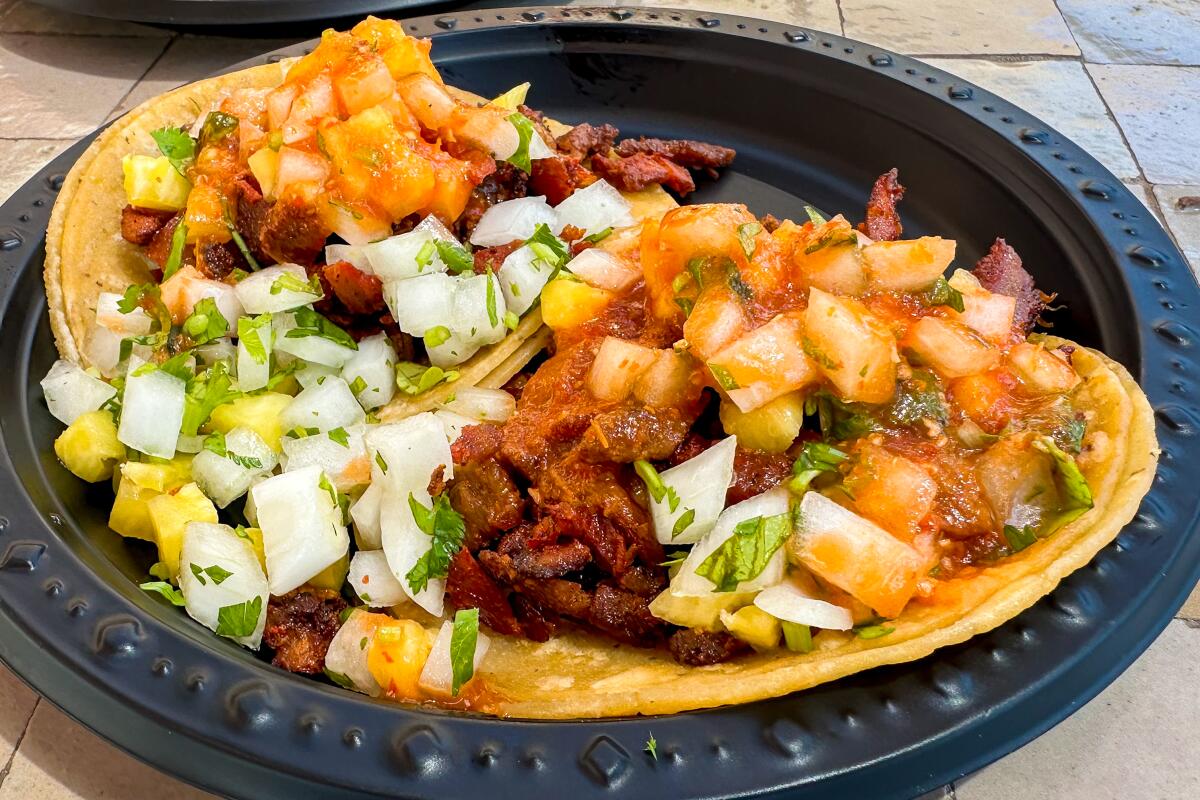
Al pastor, the well-seasoned pork shoulder shaved in layers from a trompo, is the signature meat at Tacos Los Guichos.
(Bill Addison / Los Angeles Times)
3
Al pastor and suadero tacos at Tacos Los Guichos
The dependably longest line for dining in the mercado wraps around the corner of its dedicated taqueria, a partnership with al pastor specialist Tacos Los Guichos on West Slauson Avenue in South L.A.’s Florence neighborhood. Don’t expect an exact reproduction of the Los Guichos experience in the market. At the original, the pastoreros shave the layers of meat off the trompo to order, straight onto palm-size corn tortillas. Here, the seasoned pork is pre-cut to keep up with demand, and the garnish includes the popular addition of pineapple, which Los Guichos owner Mariano Zenteno eschews at the flagship.
All that said, the outpost’s efforts ably fulfill fundamental appetites for tacos. Definitely try the chewy-crisp, thoroughly seasoned al pastor, appropriately dressed with chopped cilantro and onion, a squeeze of lime juice and a tart splash of salsa verde. Other meats include carne asada, pollo, cubed lengua (its springy bite especially good against the crisp surface of a cheese-lined mulita) and, my favorite, suadero, the confit-like cut of beef at once slick and crackly. Los Guichos also has long crafted an excellent, extra-meaty variation on torta cubana, which the mercado team faithfully duplicates.
4
Chicharrón con carne at Carnitas Don Miguel
The puesto for all things pork centers the Michoacan-style carnitas recipe developed by Don Miguel González and served in the first Northgate Market. Through picture windows, you can watch cooks in the kitchens in the back of the building simmering the meat in lard throughout the day in traditional copper cazos, which the mercardo also sells. In a region where experts render some extraordinary carnitas, these rate fine enough: tender and nicely lacy at the edges, but often a little dry.
I’ll nudge you instead to delve into fritanga (variations on fried pork), including several variations on chicharrones. A staffer wisely suggested the chicharron con carne, a warm horseshoe-shaped hunk of puffed rind with an attached ring of thick, crisp pork belly. The nuances in each shattering, porcine bite are remarkable. Ask for salsa verde to help offset the pure, saturating meatiness.
5
Goat and beef rib birrias at La Tapatia Birrieria
In this age of birria fervor, the González family takes a universalist stance on the dish’s regional variations: It invests in several options. Yes, there are quesa birria tacos, generously filled with ropy birria de res and a just-right veneer of cheese with the requisite side of chile-oil-red consommé. They’re respectable. I was far more sold on the oven-roasted goat birria, lush and humming with spice and served in soup form with the beef consommé. If you happen to be in the area for breakfast, the birrieria opens at 6 a.m. and a bowl is powerful ignition for the day. For a centerpiece at lunch or dinner, check out the whopping beef rib birria, a club of bone and flesh with meat that melts on to the fork. It doesn’t come with consommé; it needs little more than the onions, cilantro and lime wedges that come on the side.
Imagine every element of the classic al pastor taco, subbing fish for pork: the pineapple sweetness, the deep ruddy stain of achiote paste, a slick of guacamole to smooth and unite.
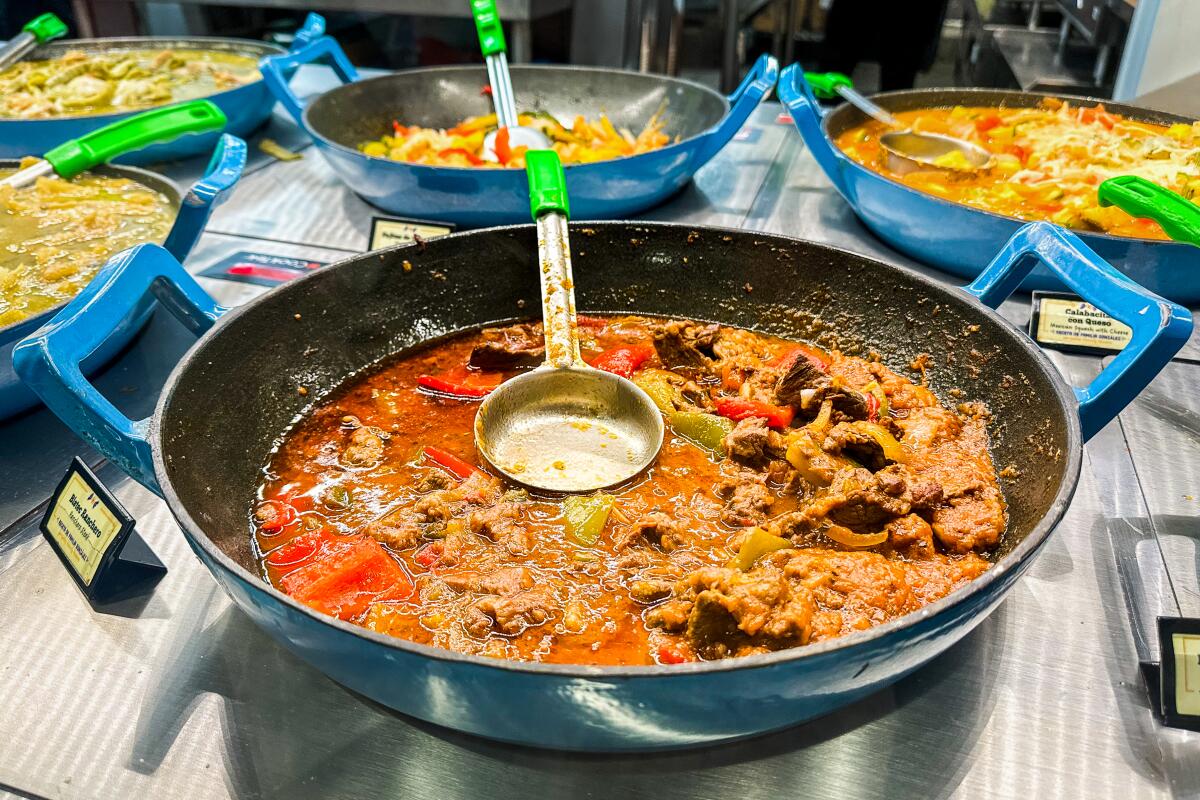
Meat and vegetable guisados or stews sit on the display counter at Guisados Las Cazuelas.
(Bill Addison / Los Angeles Times)
6
Costillas con nopales at Guisados Las Cazuelas
This puesto, without outwardly advertising it, serves several breakfast standards, including comfortingly saucy chilaquiles, eggs in salsa and oversized burritos filled with rice (an ingredient I usually prefer to skip in my bundled morning meal). This is also the corner of the market where you can sate your hunger for cheese enchiladas. I’m mostly here for the namesake guisados, stews that make a sustaining plate with Mexican rice and a pool of refried beans. They’re presented in wide, sky-blue pans atop heating pads along the counter: chicharrones simmered in red or green salsa, chunky bistec ranchero with tomatoes and, as a bright spot for vegetarians, calabacitas sprinkled with queso. The can’t-miss for omnivores: costillas (supple, bite-size pieces of pork rib) married with nopales in gently spiced broth, the kind of earthy goodness that induces a deep breath almost involuntarily.
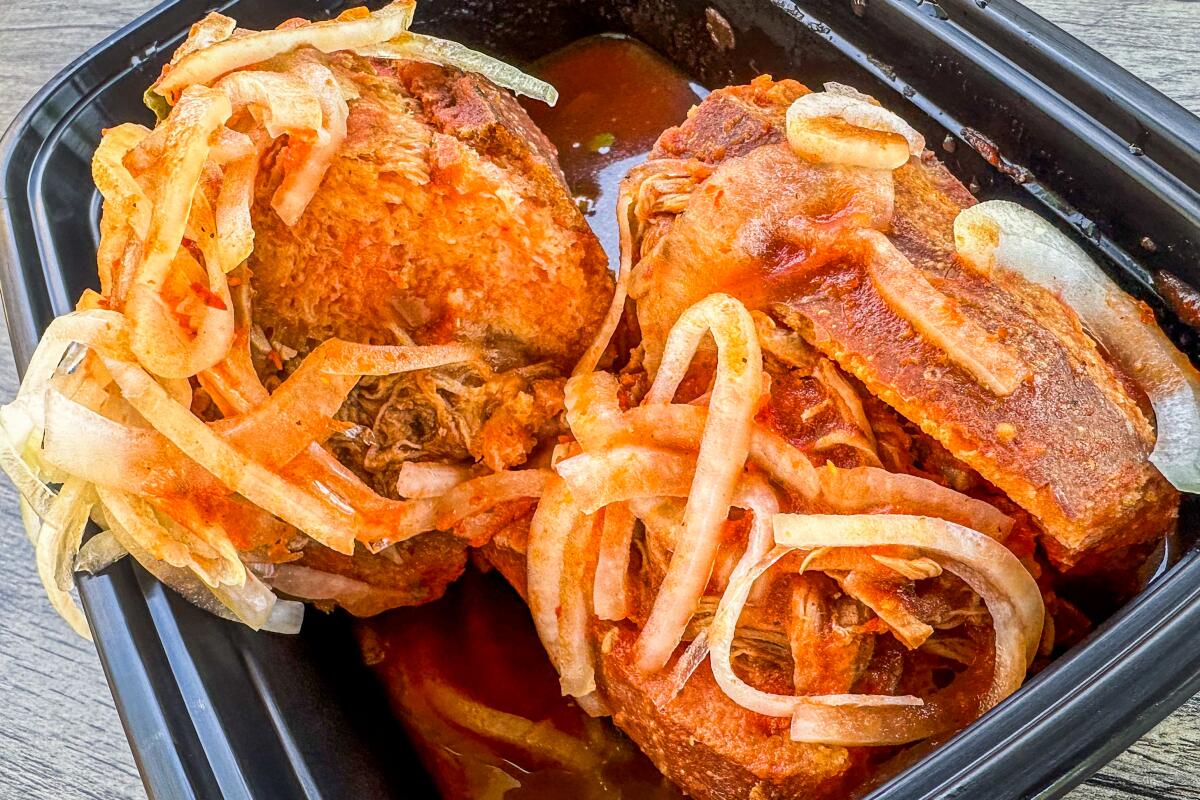
Chiva Torta, one of the puestos at Mercado González, is known for the classic torta ahogada filled with carnitas or other meats.
(Bill Addison / Los Angeles Times)
7
Torta ahogada at Chiva Torta
To add Guadalajara’s iconic sandwich into the mix, the mercado recruited the Albarran family that has operated the Chiva Torta truck in Santa Ana for over two decades. The version here closely mirrors the original. Cooks smear the insides of a crusty, intentionally well-salted bolillo called a birote salado with refried beans and then stuff the roll with meat. Carnitas are traditional — and despite my tepid opinion of the market’s carnitas, they’re my first choice, given how well their flavors blend with all the other elements — but chicken, buche (pork stomach), cueritos (pickled pork rind, a Chiva Torta signature) and barbacoa are on the roster. Pickled onions are scattered over the top before staff drenches the torta in thin tomato sauce with three levels of heat.
Know that the super spicy option will engulf the whole affair in its firestorm. Consuming the beast is messy and thrilling in its zigzags of crunch and squish and sauciness. The puesto also serves tacos dorados (an excellent way to try the cueritos) and steamed tacos de canasta filled with fluffy potatoes.
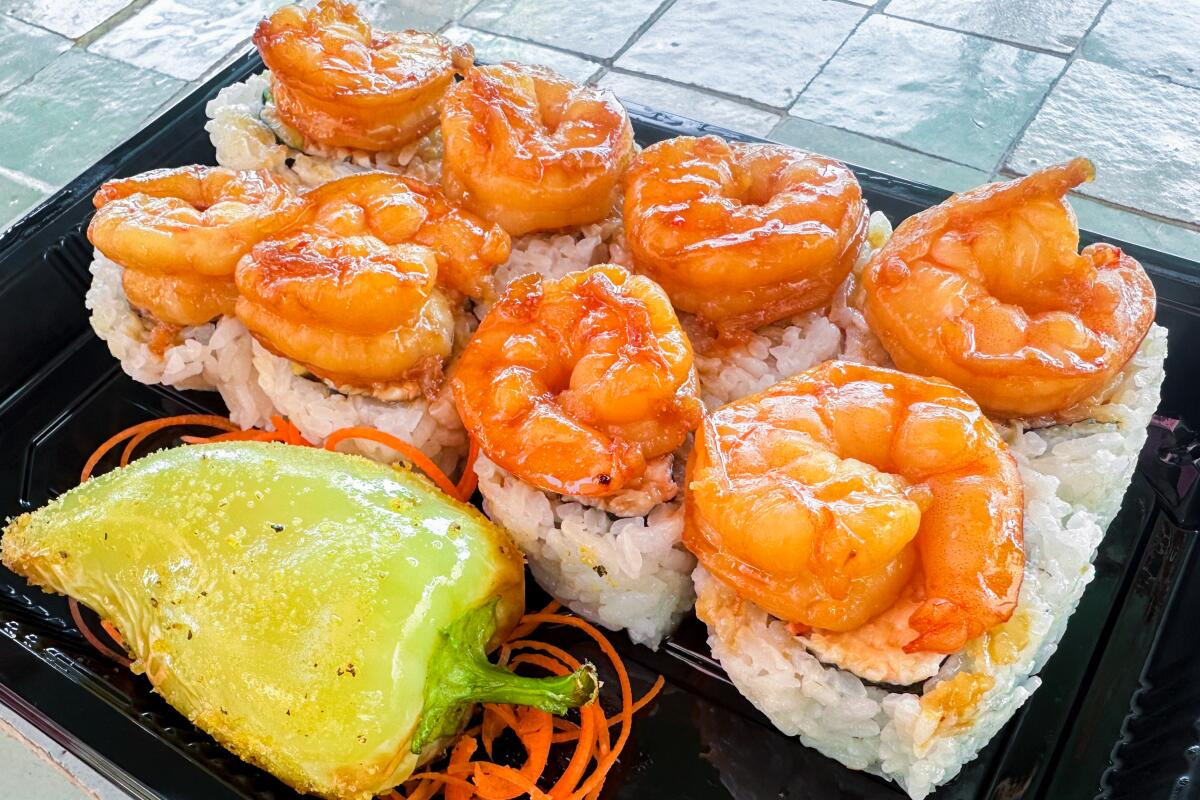
The menu at Sushi El Sinaloense includes the Mochis roll, a California roll crowned with garlic shrimp.
(Bill Addison / Los Angeles Times)
8
Mochis roll at Sushi El Sinaloense
I’ll admit to a purist streak when it comes to sushi. My tastes in maki fillings run to simple, lone ingredients: tuna, cucumber, kanpyo (dried gourd). But over the last decade plenty of Southern Californians have embraced the rising popularity of Sinaloa-style sushi, merging the joys of mariscos with extravagantly creamy, spicy, deep-fried rolls. The menu at Sushi El Sinaloense, located in a prime position near the stage in the food court, runs to starters like chiles güeros stuffed with cream cheese and imitation crab and ponzu-doused tiraditos before segueing to rolls topped with salmon, mango and avocado or lobster blanketed with mayo and squiggles of eel sauce.
For me: the more stripped-down but still artful Mochis roll, a sliced California roll with a single garlic shrimp crown atop each round. Groups ordering multiple creations might find their meal spread over a wooden tray in the shape of a boat. Seeing how many plastic containers the market goes through, even for customers eating on site, is sobering (hardly an issue exclusive to the mercado).
Mercado González in Costa Mesa is the first Mexican-style mercado of its kind in Southern California — and a sign of one city’s shifting politics.
9
Tres leches at Pastelería La González
A staple in the bakery departments of Northgate markets, the tres leches recipe needs no tweaking for Mercado González. The engineering of a boxed slice is unerring: Its poundcake density is substantial enough to maintain structure yet porous enough to absorb the milks, with just the right, rounded hit of vanilla. Customers in the market’s panaderia section will line up with their trays of conchas and other pan dulce; the tres leches isn’t on display, but the staffer behind the counter will grab one for you. They’re also frequently stocked at a refrigerated stand next to the beverage case near the food court. Find a slice surrounded by a deep moat of mixed milks for maximum soakage.
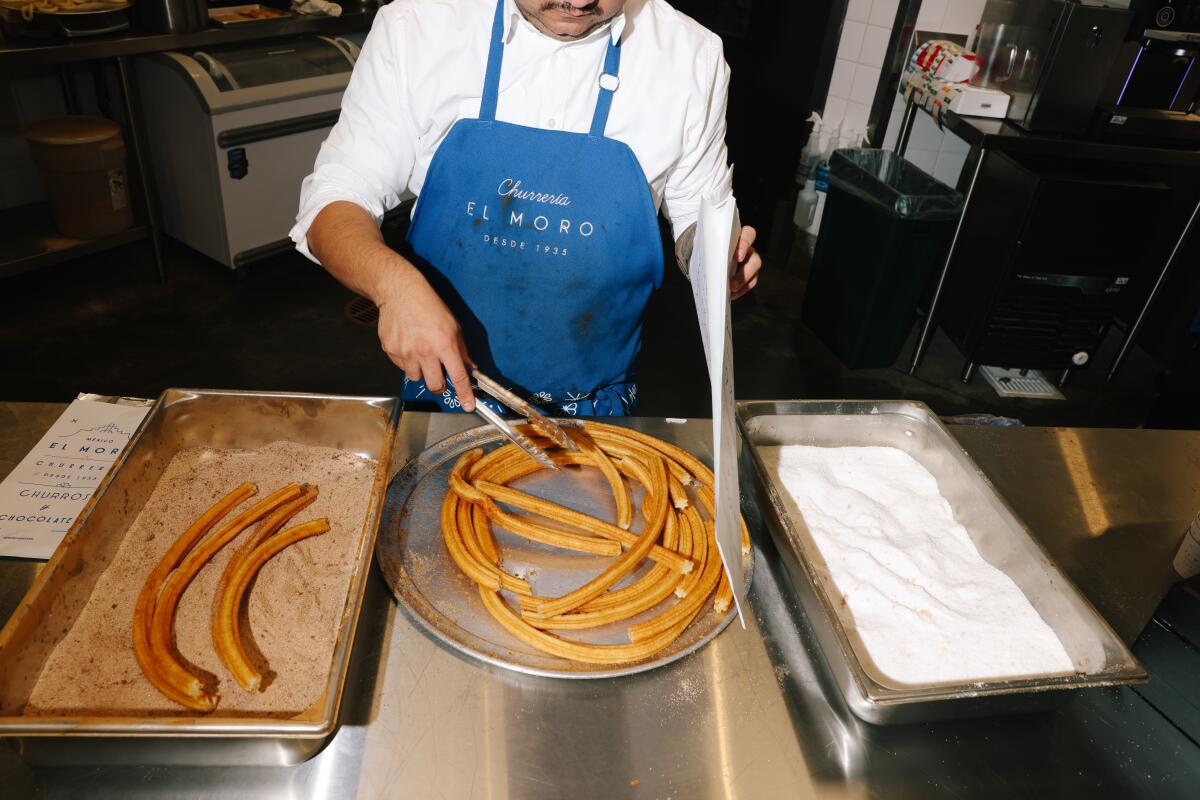
Churros are prepared at Churrería El Moro, the first outpost of the beloved Mexico City churrería in the United States.
(Dania Maxwell / Los Angeles Times)
10
Churros and cold brew at Churrería El Moro
You might be here solely for the churros. The González family triumphed by securing the first United States location of the beloved Mexico City churrería, started in 1935. While modern interpretations of churros can skew billowy and custardy, this recipe of flour, salt and water is the opposite: lanky, coiled, intensely crisp, designed to be dipped. From afternoon to evening the line can flow outside the building, moving quickly as staff fries dough to order, rolling bowed sticks in cinnamon and sugar and calling out names. Dips are a buck apiece: I lean to the essentials, chocolate and cajeta, that taste as pleasingly straightforward as you can imagine them.
Chocolate drinks, served hot or cold, run from jittery-sweet to a nicely bitter version made with cacao from Tabasco state and a flicker of cinnamon. Piloncillo, with its caramel undercurrents, and a trio of spices (clove, star anise, cinnamon) flavor the shop’s café de olla, which in true California spirit translates refreshingly well as cold brew. A narrow patio just outside the stand, decorated with El Moro’s trademark blue and white patterned tiles, can be a surprisingly calm escape.
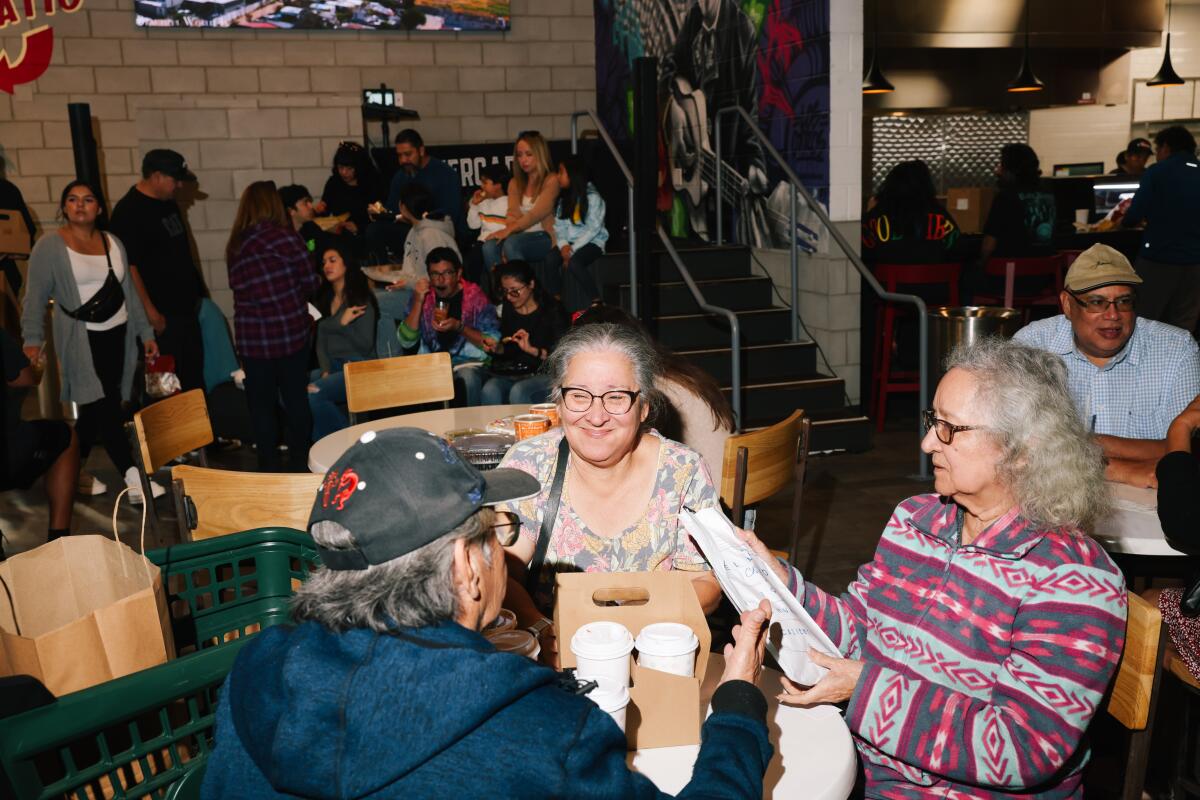
Fermin Ramirez, Rita Gomez and Isabel Gomez, left to right, chat on the communal tables at Mercado González.
(Dania Maxwell / Los Angeles Times)
11
Drinks and snacks at Maizano
It was logistically sound for the González family, when planning the mercado’s on-premise restaurant, to join forces with Gruppo Apapacho, the Mexico City-based group responsible for Terraza Cha Cha Chá, a rooftop bar in the capital city’s Tabacalera neighborhood, and for local design-forward ventures like LA Cha Cha Chá in downtown Los Angeles and seafood-focused Loreto in Frogtown. At the half-year mark, Maizano, emphasizing dishes built around masa made daily in the market, is still finding its synthesis with the project as a whole.
Until recently, its dining room might be sitting nearly empty on a Saturday night while the food court raged in full-throttle party mode. Its revolving door, the only visible connection to the restaurant inside the mercado, creates a distancing effect. Maizano also has a small patio, and as the weather warms I’ve noticed more people gravitating to the outdoor space on the edge of the parking lot, even while tables inside often remain empty.
I’m happiest at the restaurant’s handsome bar, ordering several of chef Alan Sanz’s maíz-centered snacks and sipping mezcal or cocktails crafted with restraint, like a martini of Las Californias gin and Dolin dry vermouth that substitutes a spear of pickled cactus squares for olives. The campfire perfume of smoked tuna infuses the pescadilla — sometimes, depending on the region of Mexico, rendered in the form of a fried corn tortilla but here more resembling an empanada — and the smokiness of morita salsa nicely balances a sope gilded with bone marrow. If you’re still hungry and considering a larger dish, look first to nutty, hauntingly subtle mole blanco served with broccolini and nixtamalized chayote.
And then, for a coffee or churros or a sopping slice of tres leches, rejoin the river of humanity flowing through the mercado.
